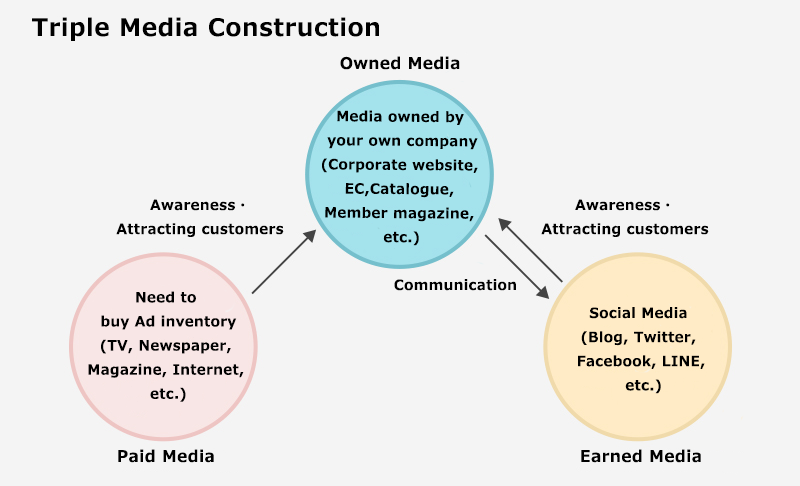
Evolution of Digital Marketing
The expansion of e-commerce and the spread of digital money as a payment method have increasingly digitalized interactions between companies and their customers. Companies can now obtain purchase histories and other customer information as digital information, leading the realm of digital marketing to be ever-expanding and increasingly sophisticated. NRI Group uses the know-how it has cultivated to support companies’ digital marketing activities.
Digital marketing using digitalized “triple media”
Digital marketing uses digital media to market products and services. Digital media usually brings to mind internet websites, but a diverse variety of other media including e-mail, mobile applications for tablets and smartphones, and digital television also fall into this category. Through these media, companies and consumers connect using electronic devices, and interactions with customers are digitalized by using e-commerce and digital money as a payment method. Companies can thereby obtain purchase histories and other customer information in the form of digital information.
From a marketing perspective, media can be divided into three marketing channels (the “triple media”): (1) “Owned Media” owned by the companies themselves, such as company-run websites, contact centers, and member magazines; (2) “Paid Media”, where advertising space is purchased, including TV commercials and listing ads; and (3) “Earned Media” centered on social media, namely blogs, Twitter, Facebook, and the like.

All the triple media are becoming increasingly digitalized, but digital media options are particularly broadening when it comes to owned media, which was formerly centered on physical stores but now takes new forms as companies step up their websites and pursue e-commerce.
Each form of media plays an important role. Paid media help increase name recognition and draw customers; earned media promotes sharing and dissemination; and owned media facilitates building relationships with customers. Industries such as manufacturing, which previously had few opportunities to interact with customers, are now able to proactively build customer relationships by strengthening their owned media.
NRI Group assists companies’ digital marketing
NRI Group has three member companies that specialize in assisting companies’ digital marketing.
One is NRI Digital, Ltd., which just launched on August 1st. NRI Digital aims to create new business models that utilize digital technology and assist our customers in each step from building business mechanisms to operating them. These endeavors will make full use of the O2O (Online to Online), omnichannel, and other expertise NRI has cultivated thus far.
The second is NRI Netcom, Ltd., which assists with customers’ web brand strategy formulation and web system provision. Fusion of technology with marketing and advertising skills is an important task for companies in their marketing activities.
NRI Netcom has specialists in every field, from strategy formulation and platform-building to data analysis and advertising operations, who work as one with customers to solve their problems and facilitate their success in digital marketing.
The third is Brierley+Partners, a U.S. company brought into the NRI Group fold in April 2015. B+P specializes in the digital marketing fields of loyalty programs and CRM (Customer Relationship Management).
The following is one of B+P’s success stories. Company A, a mid-sized fast food chain in the United States supported by B+P, decided to start a loyalty program to differentiate itself from McDonalds and other major chains. After a roughly three-month customer research and program design phase, Company A picked out their target customers, designed a program that accounted for the characteristics of their customer segments and customer experience value obtained therefrom, and implemented the program, leading to increased sales.
Specifically, toward their first target, “consumers with high purchasing potential whom Company A wanted to win away from its competitors,” Company A stepped up promotional trials for its original drink, which it was pushing to make it a popular product differentiated from other companies’ drinks. Toward their second target, already-heavy consumers, the company granted other special benefits that those customers would enjoy. Rather than implementing a uniform loyalty program, it is crucial to use digital analysis to gain a deep understanding of target customers’ behavior, discover the customers with the most potential to contribute most to profits, and provide benefits and special services to draw in those customers.